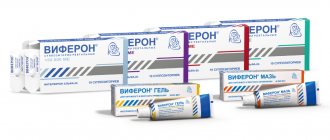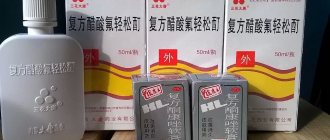Quite often the onset of cold weather is accompanied by a weakening of the immune system. This in turn leads to a decrease in the body’s susceptibility to pathogens and the development of viral infections. Usually all diseases begin with a simple runny nose, so this symptom should not be ignored. Treatment of a cold consists of fighting the cause, which is caused by pathogens localized in the nasopharynx. Therefore, nasal antiviral agents are used to treat such conditions.
When can the medicine be used?
The drug is indicated for the treatment of respiratory infections of viral etiology. The medicine effectively relieves symptoms of influenza, respiratory syncytial, rhinovirus and other infections. It is actively used to treat COVID-19, including in children, pregnant and lactating women. The medication can be used even with the addition of bacterial flora:
- Inflammation of the membranes and tissue of the brain;
- Infection in the womb (cytomegalovirus, herpes, candidiasis, chlamydia, etc.);
- Pneumonia;
- Pathologies of the reproductive organs (trichomoniasis, ureaplasmosis, HPV and others).
Viferon can be prescribed together with antibacterial and antifungal medications, as it increases the immune defense of the entire body.
The product is effective against viral intestinal diseases, namely: rotavirus, enterovirus. When using the drug, vomiting, nausea, abdominal pain, diarrhea, and intoxication quickly go away.
The medicine is often used for herpetic rashes caused by Herpes simplex types 1 and 2. The product relieves itching and rash.
The drug can be used even in newborns and premature infants. It does not cause serious complications and is non-toxic.
Causes
Sinusitis can be acute or chronic. In the case of an acute process, its main cause is a viral infection. Damage to the cells of the nasal mucosa by viruses leads to its swelling and cessation of normal air exchange in the nasal cavity and paranasal sinuses. There is a decrease in pressure in the sinuses below atmospheric pressure, which increases the formation of mucus. There is stagnation of the sinus contents, in which bacterial flora easily multiplies. As a result, purulent inflammation occurs.
Treatment of sinuses usually results in recovery. However, there are factors that contribute to the chronicity of the inflammatory process:
- anatomical changes - curvature of the nasal septum, hypertrophy of the nasal turbinates, which change the direction of air flow in the nasal cavity and complicate the aeration of the paranasal sinuses;
- diseases of the teeth of the upper jaw, which can cause infection to enter the maxillary sinus after tooth extraction, through blood vessels or even as a result of filling material entering the sinus;
- long-term diseases of the oral cavity and nasopharynx - rhinitis, tonsillitis, which are a constant source of pathogens.
Instructions for use
The medicine in suppositories is used rectally (the suppository is inserted into the anus). To insert suppositories correctly, you need to spread your buttocks and insert a suppository into the anus. After administering the medicine, you should lie down for half an hour. During this time the candle will dissolve.
Now we will tell you how to place a Viferon suppository rectally for a baby. For children, suppositories are administered in a position on their side (newborns) or on their stomach (children over 1 year). To administer the medication, spread the buttocks and insert a suppository into the anus. Next, squeeze the gluteal muscles and hold the child in this position for 2-3 minutes (since the candle may slip out). After administering the drug, the baby should lie down for half an hour.
Can Viferon be used by children?
Viferon suppositories can be used by children of different ages. Doses of medication for infection in newborns and premature infants:
- Prematures with a gestational age of more than 34 weeks, 150,000 IU twice a day. The interval between doses is 12 hours. The duration of course therapy is 5 days.
- Premature babies less than 34 weeks - 150,000 IU three times a day (every 8 hours) for 5 days.
Children under 7 years of age with ARVI are also advised to take Viferon 150,000 IU twice a day. Course therapy lasts up to 5 days. If treatment is ineffective, you should see a pediatrician.
The number of courses of treatment may vary depending on the type of disease:
- flu - 1-2,
- cytomegalovirus infection - 2-3,
- enterovirus infection - 2-3,
- pneumonia (as a complication after a viral infection) - 1-2,
- herpes - 2.
The number of courses is determined by the doctor. The interval between them is 5-6 days.
According to research, with coronavirus, children under 7 years of age can be prescribed up to 1,000,000 IU 2 times a day. And for children over 8 years old, up to 3,000,000 IU twice a day. The duration of therapy is 7-14 days, depending on the severity of the pathology. Treatment with high doses allows you to quickly remove the pathogen from the body.
For viral hepatitis B, C, D, it is recommended to prescribe Viferon suppositories:
- Under 6 months of age: 3,000,000-5,000,000 IU per day;
- Up to 12 months of age: 5,000,000 IU per day;
- 1-7 years: 3,000,000 per 1 square meter of body surface area per day;
- Over 7 years of age - 5,000,000 IU per 1 square meter of body surface area per day.
In the first 1.5 weeks of therapy, the medicine is taken twice a day. Next, candles are placed every other day for six months to a year.
Treatment of various infections in adult patients
In adults, for ARVI, influenza and other pathologies of viral etiology, 500,000 IU is prescribed twice a day. Therapy lasts 5-10 days. If treatment needs to be continued, after completing the first course, take a break for 5 days, after which the therapy is repeated.
Pathologies caused by the herpes virus are indicated to be treated with a dosage of 1,000,000 IU twice a day. The course of treatment lasts 1.5 weeks. With frequent relapses, the course of therapy can last more than 1.5 weeks.
During pregnancy with a viral urogenital infection (including herpes), it is recommended to put a suppository of 500,000 IU twice a day for 1.5 weeks. Then twice a week, 1,000,000 IU per day (course therapy - 1.5 weeks). After a month, preventive therapy is indicated at a dose of 150,000 IU twice a day for 5 days. It is possible to repeat prophylaxis before childbirth.
For viral hepatitis, the medicine is indicated in a dose of 3,000,000 IU twice a day every day for 1.5 weeks. Afterwards, a maintenance course of 3,000,000 IU is prescribed every other day for six months to a year. The duration of therapy is determined by the doctor depending on the results of laboratory tests and the patient’s well-being.
For the drug to work correctly, you need to know where to store Viferon suppositories. The medication should be stored in a cool place so that the candle keeps its shape and does not melt. The optimal temperature is 2–8 °C.
Ointment and gel - rules of use
Ointment or gel is often used to treat herpes on the skin and mucous membranes. A single dosage is 0.5 cm. The drug is applied to the skin or mucous membrane (nasal passages, tonsils) 3-5 times a day. The surfaces to be treated must be pre-cleaned. The duration of therapy is 5 days. External agents are indicated simultaneously with Viferon suppositories.
The gel can be used to treat inflammatory processes of the cervix. The product is applied twice a day. Before use, it is recommended to clean the cervical mucosa with a cotton swab so that there is no mucus. The course of therapy is 1-2 weeks. The gel is also used as part of the general treatment of cervicitis.
Attention! The tube should be stored in a cool place. Otherwise, the effectiveness of treatment is reduced.
For preventive purposes, external forms are recommended to be applied to the tonsils or nasal mucosa twice a day. Course therapy lasts up to 1 month.
Gel Viferon 36,000 ME
Treatment
Therapeutic measures for sinusitis are aimed at fighting infection, interrupting the pathological mechanisms of the disease and relieving symptoms. It is performed on an outpatient basis. The patient is hospitalized in the following situations:
- severe infectious process with fever, intoxication, especially in children and the elderly;
- the appearance of severe headache, blurred vision or neurological symptoms;
- spread of pain to the orbital area;
- long-term use of immunosuppressants or glucocorticoids, as well as other immunodeficiencies.
Treatment at home
Home remedies can help relieve the pain and fullness of acute sinusitis. They improve sinus drainage and increase the effectiveness of other treatments. Basic recommendations:
- drink more warm liquids to keep the nasal mucosa hydrated;
- breathe warm, moist air, use humidifiers, do not go out into the cold;
- rinse your nose with a solution of table or sea salt, and also gargle with it;
- if necessary, blow your nose, do it carefully, without closing any of the nostrils;
- do not drink alcohol, which causes swelling of the nasal mucosa.
Drug therapy
The mainstay of treatment for sinus inflammation is antibiotics. Amoxicillin, amoxicillin clavulanate, cephalosporins, macrolides, and fluoroquinolones are used. For fungal infections, amphotericin B and fluconazole are used.
Additional medications for sinusitis:
- decongestants in the form of nasal drops or sprays for no more than 5 days; these drugs constrict blood vessels, relieve swelling of the mucous membrane and create conditions for the outflow of pathological sinus contents;
- antihistamines are indicated for bacterial sinusitis with signs of an allergic reaction; they dry out the mucous membrane and relieve swelling;
- painkillers, such as NSAIDs;
- local use of antiseptics (rinsing the nose with furatsilin solution), irrigation therapy (Miramistin, Aqualor, Dolphin, products based on sea water or saline with the addition of iodine);
- for chronic sinusitis (except for the odontogenic variant), a course of use of glucocorticoid-based sprays that suppress inflammation is acceptable; a doctor must prescribe them.
Traditional medicine
Such recipes help improve nasal breathing, relieve inflammation and swelling, and strengthen local immunity. They should only be used in combination with drug therapy after consultation with a doctor. The following tools may help:
- inhalation based on crushed garlic mixed with apple cider vinegar;
- insertion into the nose of tampons soaked in a mixture of onion juice, honey and sunflower oil;
- instillation of aloe juice, radish, onion, a mixture of beet juice and honey, propolis into the nose;
- compresses on the affected sinus area with a decoction of calendula, plantain, and chamomile.
Operation
Such surgical intervention as puncture of the affected sinus with removal of pus and rinsing the cavity with antiseptics is now rarely performed. It is believed that this is an invasive intervention, which is often accompanied by complications (damage to the orbit, upper jaw, air embolism, and others). It is usually indicated for patients with severe acute sinusitis
For the treatment of chronic sinusitis, other surgical techniques are used, both traditional with open intervention on the sinuses, and minimally invasive using endoscopic techniques:
- interventions aimed at eliminating anatomical deformations - septoplasty, removal of adenoids and others;
- intranasal antrostomy - creating an opening in the wall of the maxillary sinus into the nasal cavity;
- radical antrostomy - creation of a permanent drainage hole with removal of part of the bony wall of the sinus.
special instructions
The drug should not be used for generalized or atypical herpetic infections. Since the medicine can cause an allergic reaction, it is not prescribed for atopic dermatitis or eczematous rashes. The drug is not recommended for:
- tumor processes on the skin,
- familial pemphigus Gougereau-Hailey,
- mental disorders,
- simultaneous use of sedative drugs,
- neutropenia less than 1.5×109,
- the platelet count in the blood is less than 90,000/µl,
- diseases in which there is a disruption of the central nervous system.
Contraindications
There are contraindications for the flu shot:
- age up to six months;
- presence of allergies to the components of the drug;
- severe reaction to a previous vaccination.
Children who have:
- egg allergy;
- dysfunction of the immune system.
In any case, before vaccination, you must be examined by a doctor and undergo tests. Two weeks before the vaccination date, it is advisable to avoid traveling. If you are prone to allergies, you should start giving antihistamines three days before the procedure. If a child falls ill within three weeks before vaccination, it is recommended to postpone the vaccination date to a later date.
Analogues of the drug Viferon
Viferon has its own structural and non-structural analogues. Structural analogues include Grippferon, Kipferon. They also contain human recombinant interferon alpha-2b. Grippferon differs only in the release form (drops, spray). Kipferon is produced in candles.
Is it possible to combine Viferon and Kipferon? The combined use of drugs is not recommended, since they have the same active ingredient. With simultaneous use, an overdose or an allergic reaction is possible.
Non-structural analogues include:
- Anaferon - contains antibodies to human interferon gamma; less effective, allowed from 1 month;
- Arbidol - indicated from 3 years of age, for example, for coronavirus and influenza, has a less pronounced clinical effect in relation to acute respiratory viral infections, and is not used at all for bacterial infections, since it has a targeted effect on viral particles;
- Kagocel is an interferon inducer, affects the production of its own interferons, and is not indicated for infants and children under 3 years of age.
Viferon is the most effective medicine among all antiviral drugs. It has proven itself in the treatment of influenza, coronavirus and other acute respiratory viral infections in adults and children. Due to the lack of toxicity and undesirable effects, it can be used in pregnant women and newborns. The medicine is ideal for the prevention of viral diseases and is used as part of the general treatment of bacterial infections.
Prevention of ARVI in children in kindergarten
In preschool institutions, sanitary and hygienic standards are constantly observed, and measures are taken to prevent the development of viral diseases, for example:
- air baths and hardening procedures (usually include gymnastic exercises, walking barefoot on a special surface);
- quartzing of premises.
It is equally important for parents to take precautions: if the baby shows the first signs of illness (stuffy or runny nose, coughing, etc.), you need to cancel your visit to the facility.










